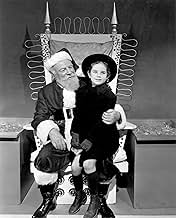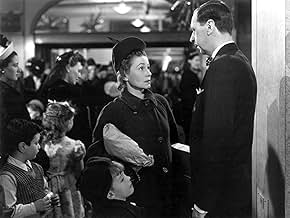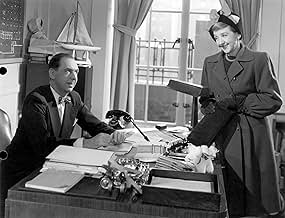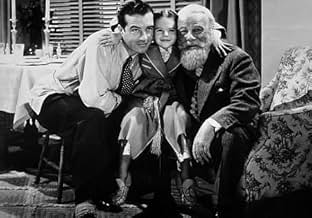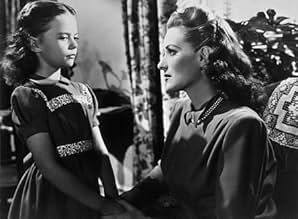VALUTAZIONE IMDb
7,9/10
58.198
LA TUA VALUTAZIONE
Quando un simpatico vecchietto sostiene di essere Babbo Natale, viene internato e considerato pazzo, un giovane avvocato decide di difenderlo.Quando un simpatico vecchietto sostiene di essere Babbo Natale, viene internato e considerato pazzo, un giovane avvocato decide di difenderlo.Quando un simpatico vecchietto sostiene di essere Babbo Natale, viene internato e considerato pazzo, un giovane avvocato decide di difenderlo.
- Regia
- Sceneggiatura
- Star
- Vincitore di 3 Oscar
- 10 vittorie e 1 candidatura in totale
Jack Albertson
- Post Office Mail Sorter Next to Lou
- (non citato nei titoli originali)
Harry Antrim
- Mr. R.H. Macy
- (non citato nei titoli originali)
Arline Bletcher
- Courtroom Spectator
- (non citato nei titoli originali)
Lela Bliss
- Mrs. Shellhammer
- (non citato nei titoli originali)
Symona Boniface
- Courtroom Spectator
- (non citato nei titoli originali)
Walden Boyle
- Judge's Clerk
- (non citato nei titoli originali)
Kevin Burke
- Child on Santa's Lap
- (non citato nei titoli originali)
Dorothy Christy
- Secretary
- (non citato nei titoli originali)
Dick Cogan
- Department Store Head
- (non citato nei titoli originali)
Recensioni in evidenza
Miracle On 34Th Street was a great Christmas movie. The major conflict of the movie was whether or not Santa Claus really existed.
The movie begins with Kris Cringle (Edmund Gwen) walking by a store with a man setting up a display of reindeer and notices that they are not in order. Kris tells the man politely how to fix them in the right positions, but the man gives him a strange look and goes back to work. Kris Cringle believes himself to be Santa Claus although most everyone else thinks he is crazy. Even little Susan (Natalie Wood) thinks he is a fake and doesn't believe in any fairytales'. Her mother, Doris Walker (Maureen O'Hara), taught her that to believe in fairytales' is childish and impractical. Kris is later made a part of the Macy's parade when the Santa Claus that was supposed to be in the parade is found drunk. When asked if he had ever had any experience, Kris replied, `Many times.' Doris makes him the department store Santa Claus at Macy's where he tells many people that he is the real Santa Claus.
As more people find out about Kris Cringle calling himself Santa Claus', they get upset saying that no such person really exists. Many people took it more literally and said that it would be impossible for reindeer to fly or for anyone to live in the North Pole. He is forced to take a mental examination and the doctor convinces Doris that Kris is mentally ill after he gets in a fight. Kris is arrested and taken to court and his lawyer is Mr. Gailey who starts to believe, along with Doris and Susan, the he actually is Santa Claus.
I thought that this was a really good holiday movie that focus on something that all of us as little kids went through- believing or not believing in Santa Claus. It even feels like I should believe in Santa after watching it. I thought that Edmund Gwen was a really good actor and perfect for his part. He played his role very innocently, which made him very believable as Santa Claus. Natalie Wood was a great actress who played very well the typical role of the cynical child. The acting and the plot was very well written. It was a very innocent movie that is entertaining for all types of audiences.
The movie begins with Kris Cringle (Edmund Gwen) walking by a store with a man setting up a display of reindeer and notices that they are not in order. Kris tells the man politely how to fix them in the right positions, but the man gives him a strange look and goes back to work. Kris Cringle believes himself to be Santa Claus although most everyone else thinks he is crazy. Even little Susan (Natalie Wood) thinks he is a fake and doesn't believe in any fairytales'. Her mother, Doris Walker (Maureen O'Hara), taught her that to believe in fairytales' is childish and impractical. Kris is later made a part of the Macy's parade when the Santa Claus that was supposed to be in the parade is found drunk. When asked if he had ever had any experience, Kris replied, `Many times.' Doris makes him the department store Santa Claus at Macy's where he tells many people that he is the real Santa Claus.
As more people find out about Kris Cringle calling himself Santa Claus', they get upset saying that no such person really exists. Many people took it more literally and said that it would be impossible for reindeer to fly or for anyone to live in the North Pole. He is forced to take a mental examination and the doctor convinces Doris that Kris is mentally ill after he gets in a fight. Kris is arrested and taken to court and his lawyer is Mr. Gailey who starts to believe, along with Doris and Susan, the he actually is Santa Claus.
I thought that this was a really good holiday movie that focus on something that all of us as little kids went through- believing or not believing in Santa Claus. It even feels like I should believe in Santa after watching it. I thought that Edmund Gwen was a really good actor and perfect for his part. He played his role very innocently, which made him very believable as Santa Claus. Natalie Wood was a great actress who played very well the typical role of the cynical child. The acting and the plot was very well written. It was a very innocent movie that is entertaining for all types of audiences.
This is certainly a lovely warmhearted movie, but since other reviewers have described the plot in detail, I'll move on to other topics.
I love movies like this for the insight they provide into the customs of a lost era. Watch the clothing - everybody is so dressed up! - women in dresses, gloves, and hats, men in hats and suits. Notice that when O'Hara enters a room filled with Macy's executives, even though they are the bosses and she is lower management, they all stand up instantly.
The social satire, most on display in the courtroom scenes, also is very 1940s. Apparently audiences of that era took a kind of genial corruption in the judicial system in stride. Business leaders, like "Mr. Macy" were expected to be sharp and profit-oriented, but also decent people like the rest of us. It's a much more nuanced view than the "businessman as criminal villain" so common in today's movies.
The character played by Maureen O'Hara probably needs explanation for modern viewers. Late 1940s audiences knew that the social and economic situation of a divorced working woman with a child was much more precarious than it is now. Divorce was still somewhat shocking - this is brought out neatly in the movie when her would-be lover does a double take when he learns from her daughter about the divorce - he probably had assumed she was a war widow. Divorced moms were still rare in the middle classes. Society universally agreed that women should stay home to raise their children. Economically, women in management positions were still very rare, couldn't expect promotion, and were last hired, first fired. I think O'Hara's performance brings out these qualities in a way that the audience of the 1940s would have understood easily. The character's stiffness, fear of losing control, and anxiety about her job make a great deal of sense. It would have been nice to see a few scenes showing her loosening up, perhaps at dinner with her boyfriend; no doubt those got left on the cutting room floor.
I really like the scene where Santa talks to the little Dutch orphan. First, this scene also must have resonated with the audience; in 1947 the western European countries had only started to recover from World War II, and probably many Americans were familiar with the idea of adopting a war orphan, just as many sent CARE packages. Second, by making Santa fluent in Dutch, the writer cleverly left the viewer thinking that hey, he might really be Santa Claus (isn't Santa Claus fluent in all languages)?
Some reviewers don't like the acting and think that modern actors are "better". I think the older actors aren't better or worse, just different. The audiences of the 1940s expected a certain style of acting, and the directors and actors gave that to them. Then as now, Hollywood paid top dollar and got very talented people, but like all of us they were shaped by their own time and place, more particularly the requirement to make movies that audiences would like. Move Maureen O'Hara to 2004, or Tom Cruise to 1947, and you'd see them acting in the style of that decade.
I love movies like this for the insight they provide into the customs of a lost era. Watch the clothing - everybody is so dressed up! - women in dresses, gloves, and hats, men in hats and suits. Notice that when O'Hara enters a room filled with Macy's executives, even though they are the bosses and she is lower management, they all stand up instantly.
The social satire, most on display in the courtroom scenes, also is very 1940s. Apparently audiences of that era took a kind of genial corruption in the judicial system in stride. Business leaders, like "Mr. Macy" were expected to be sharp and profit-oriented, but also decent people like the rest of us. It's a much more nuanced view than the "businessman as criminal villain" so common in today's movies.
The character played by Maureen O'Hara probably needs explanation for modern viewers. Late 1940s audiences knew that the social and economic situation of a divorced working woman with a child was much more precarious than it is now. Divorce was still somewhat shocking - this is brought out neatly in the movie when her would-be lover does a double take when he learns from her daughter about the divorce - he probably had assumed she was a war widow. Divorced moms were still rare in the middle classes. Society universally agreed that women should stay home to raise their children. Economically, women in management positions were still very rare, couldn't expect promotion, and were last hired, first fired. I think O'Hara's performance brings out these qualities in a way that the audience of the 1940s would have understood easily. The character's stiffness, fear of losing control, and anxiety about her job make a great deal of sense. It would have been nice to see a few scenes showing her loosening up, perhaps at dinner with her boyfriend; no doubt those got left on the cutting room floor.
I really like the scene where Santa talks to the little Dutch orphan. First, this scene also must have resonated with the audience; in 1947 the western European countries had only started to recover from World War II, and probably many Americans were familiar with the idea of adopting a war orphan, just as many sent CARE packages. Second, by making Santa fluent in Dutch, the writer cleverly left the viewer thinking that hey, he might really be Santa Claus (isn't Santa Claus fluent in all languages)?
Some reviewers don't like the acting and think that modern actors are "better". I think the older actors aren't better or worse, just different. The audiences of the 1940s expected a certain style of acting, and the directors and actors gave that to them. Then as now, Hollywood paid top dollar and got very talented people, but like all of us they were shaped by their own time and place, more particularly the requirement to make movies that audiences would like. Move Maureen O'Hara to 2004, or Tom Cruise to 1947, and you'd see them acting in the style of that decade.
A wholesome and magical film that captures the goodwill and essence of Christmas. A well made production. A good balance was struck between the magical nature of Kris Kringle and reality. This film warms the heart, encourages your imagination and respects your intelligence all at the same time. Interesting and fascinating from start to finish. Some great performances to bring this classic film to life.
...............Santa Claus has come to town. Or at least that's what a gentlemen appropriately named Kristopher Kringle played by Edmund Gwenn complete with full white beard is claiming. He makes his appearance at the Thanksgiving Day Parade as sponsored by R.H. Macy's Department Store and finds the Santa hired for the occasion, Percy Helton, full of a little too much Christmas cheer already. In charge of the parade is one of Macy's middle level executives, Maureen O'Hara, who fires Helton and hires Gwenn right then and there.
Gwenn's obvious sincerity makes him an ideal Santa Claus for Macy's and for us. He spreads the real meaning of Christmas around even has Macy's declaring a holiday truce with its rival Gimbel's. That's a part of Miracle on 34th Street that might be lost to viewers today. Gimbel's was Macy's big department store rival and it's flagship store in New York stood across 34th Street at the time. Gives a meaning to the title that is lost on today's audience.
But wiser and more sophisticated folks like the majority of us know there ain't no such thing as Santa Claus. Even Maureen O'Hara knows that and imparts it to her daughter Natalie Wood. Gwenn's just a kind old man in a white beard. But when his sanity is questioned, Gwenn's belief becomes a matter for the courts where Gwenn is ably defended by O'Hara's boyfriend, lawyer John Payne.
Like that other holiday classic It's A Wonderful Life, Christmas is never complete without seeing Miracle on 34th Street. Though New York has changed considerably since 1947 the year I made my earthly debut, the film has lost absolutely none of its charm.
Edmund Gwenn won the Best Supporting Actor of 1947 and in doing so, beat out his best friend, Finlay Currie, who was up that year for playing Magwitch in Great Expectations. The two had met in stock companies in their native Scotland and were friends right up to when Gwenn passed away in 1959. The Oscar was the high point of his career.
Maureen O'Hara in her memoirs says that Miracle on 34th Street holds a special place in her affections. In fact until Gwenn died, she had hopes of doing some kind of sequel. She bonded on stage with young Natalie Wood who later played her daughter in Father Was A Fullback also and kept in contact with her right up to her death in 1981.
Maureen also had a deep affection for John Payne who she made four films with and says was one of the nicest men in the world. One story she related was on the set of another film they made, Payne was served with divorce papers right on the set from his then wife, Anne Shirley. She said he broke down and cried like a baby. If it weren't for the fact she was married, she said she definitely could have gotten something going with Payne.
In the supporting cast note the presence of one grinch in the person of Porter Hall who played one of his patented nasty little meanies. His meddling and general misanthropy cause Gwenn to have that trial in the first place. Look for a bit role from Jack Albertson as the postal employee who inadvertently saves the day. Also making her film debut is Thelma Ritter as the mother of a child looking to meet Santa Claus, the one official Santa Claus, courtesy of Macy's Department Store.
Although Miracle on 34th Street has been remade several times over the years, this one is the genuine article. As genuine as the fact that Macy's has the official Santa Claus as certified by a higher authority.
One thing has always puzzled me though. How long did it take Edmund Gwenn to grow that beard for the part?
Gwenn's obvious sincerity makes him an ideal Santa Claus for Macy's and for us. He spreads the real meaning of Christmas around even has Macy's declaring a holiday truce with its rival Gimbel's. That's a part of Miracle on 34th Street that might be lost to viewers today. Gimbel's was Macy's big department store rival and it's flagship store in New York stood across 34th Street at the time. Gives a meaning to the title that is lost on today's audience.
But wiser and more sophisticated folks like the majority of us know there ain't no such thing as Santa Claus. Even Maureen O'Hara knows that and imparts it to her daughter Natalie Wood. Gwenn's just a kind old man in a white beard. But when his sanity is questioned, Gwenn's belief becomes a matter for the courts where Gwenn is ably defended by O'Hara's boyfriend, lawyer John Payne.
Like that other holiday classic It's A Wonderful Life, Christmas is never complete without seeing Miracle on 34th Street. Though New York has changed considerably since 1947 the year I made my earthly debut, the film has lost absolutely none of its charm.
Edmund Gwenn won the Best Supporting Actor of 1947 and in doing so, beat out his best friend, Finlay Currie, who was up that year for playing Magwitch in Great Expectations. The two had met in stock companies in their native Scotland and were friends right up to when Gwenn passed away in 1959. The Oscar was the high point of his career.
Maureen O'Hara in her memoirs says that Miracle on 34th Street holds a special place in her affections. In fact until Gwenn died, she had hopes of doing some kind of sequel. She bonded on stage with young Natalie Wood who later played her daughter in Father Was A Fullback also and kept in contact with her right up to her death in 1981.
Maureen also had a deep affection for John Payne who she made four films with and says was one of the nicest men in the world. One story she related was on the set of another film they made, Payne was served with divorce papers right on the set from his then wife, Anne Shirley. She said he broke down and cried like a baby. If it weren't for the fact she was married, she said she definitely could have gotten something going with Payne.
In the supporting cast note the presence of one grinch in the person of Porter Hall who played one of his patented nasty little meanies. His meddling and general misanthropy cause Gwenn to have that trial in the first place. Look for a bit role from Jack Albertson as the postal employee who inadvertently saves the day. Also making her film debut is Thelma Ritter as the mother of a child looking to meet Santa Claus, the one official Santa Claus, courtesy of Macy's Department Store.
Although Miracle on 34th Street has been remade several times over the years, this one is the genuine article. As genuine as the fact that Macy's has the official Santa Claus as certified by a higher authority.
One thing has always puzzled me though. How long did it take Edmund Gwenn to grow that beard for the part?
The movie starts out in a festive atmosphere. It is Thanksgiving and the employees of Macy's department store are busy with preparations for the annual Thanksgiving day parade. Doris. Walker (Maureen O'Hare) is in charge of the parade. She anxiously hires Kris Kringle (Edmund Gwenn) to replace the man she hired to play Santa Claus when she discovers the original Santa is too intoxicated to even get on the float. Kris does such a good job that Mrs. Walker asks him to stay on in the role and be the department store's Santa. She soon has serious doubts about her decision when she discovers that her new Santa really believes he is Santa Claus.
Mrs. Walker is working, single mother, who works for Macy's Department Store in New York City. Natalie Wood plays her daughter, Susan. As the result of a failed Marriage, Doris raises her daughter to accept reality. There is no room for fantasy or make believe in her life. Susan is a quiet, child who acts more like a grown up than a 6 year old. She has difficulty using her imagination, and has become just as skeptical as her mother.
Since Kris, believes that "the important thing is to make children happy," winning the affection of Susan and her mother is his main objective.
Whether or not Kris is the real Santa Claus, there is no doubt that he seem to have an influence on almost everyone he meets--except for Macy's staff psychologist .Mr. Sawyer believes that Kris is delusional, and has him committed to thrown into a mental institution. In order to get out, Kris must face a court hearing, where not only is his sanity questioned, but the state of New York will decide if there really is a Santa Claus. Fred Gailey (played by John Payne) a neighbor of Doris Susan Walker agrees to represent Kris. The predictable end to the story is that Fred and Doris become attracted to each other, and as Fred works hard to secure Kris' freedom, Doris finds herself not only believing in Kris, but also in believing in fantasy.
Maureen O'Hara portrays Doris Walker with poise and sophistication. Although the movie is over 55 years old, the idea of a single working mom trying to raise her daughter after a bitter divorce, tells a story that is relevant by today's standards. Natalie Wood does such a good job at playing as the bright six year old, Susan, that you can almost imagine her going straight from being a baby to being an adult. John Payne, as Fred Gailey, predictably plays the handsome attorney who falls in love with Mrs. Walker. Even though it seems a bit unbelievable, this movie is all about fantasy, so we'll allow a bit of romance. Finally, Edmund Gwenn's portrayal of Santa Claus is so believable, that you almost believe that truly is the jolly old elf himself!
This reviewer would give the movie a 5 out of 5 rating. It is a Christmas classic that will be remembered for years to come as one of the best Christmas movies ever filmed. The message of the movie is not about the real meaning of Christmas, nor is it about the commercialism that has overshadowed the holiday for years. The message of the movie is that make believe and fantasy play an important role in our live. Without them we would have no basis for our hopes and dreams
Mrs. Walker is working, single mother, who works for Macy's Department Store in New York City. Natalie Wood plays her daughter, Susan. As the result of a failed Marriage, Doris raises her daughter to accept reality. There is no room for fantasy or make believe in her life. Susan is a quiet, child who acts more like a grown up than a 6 year old. She has difficulty using her imagination, and has become just as skeptical as her mother.
Since Kris, believes that "the important thing is to make children happy," winning the affection of Susan and her mother is his main objective.
Whether or not Kris is the real Santa Claus, there is no doubt that he seem to have an influence on almost everyone he meets--except for Macy's staff psychologist .Mr. Sawyer believes that Kris is delusional, and has him committed to thrown into a mental institution. In order to get out, Kris must face a court hearing, where not only is his sanity questioned, but the state of New York will decide if there really is a Santa Claus. Fred Gailey (played by John Payne) a neighbor of Doris Susan Walker agrees to represent Kris. The predictable end to the story is that Fred and Doris become attracted to each other, and as Fred works hard to secure Kris' freedom, Doris finds herself not only believing in Kris, but also in believing in fantasy.
Maureen O'Hara portrays Doris Walker with poise and sophistication. Although the movie is over 55 years old, the idea of a single working mom trying to raise her daughter after a bitter divorce, tells a story that is relevant by today's standards. Natalie Wood does such a good job at playing as the bright six year old, Susan, that you can almost imagine her going straight from being a baby to being an adult. John Payne, as Fred Gailey, predictably plays the handsome attorney who falls in love with Mrs. Walker. Even though it seems a bit unbelievable, this movie is all about fantasy, so we'll allow a bit of romance. Finally, Edmund Gwenn's portrayal of Santa Claus is so believable, that you almost believe that truly is the jolly old elf himself!
This reviewer would give the movie a 5 out of 5 rating. It is a Christmas classic that will be remembered for years to come as one of the best Christmas movies ever filmed. The message of the movie is not about the real meaning of Christmas, nor is it about the commercialism that has overshadowed the holiday for years. The message of the movie is that make believe and fantasy play an important role in our live. Without them we would have no basis for our hopes and dreams
Lo sapevi?
- QuizIn the untranslated dialogue with the Dutch girl, Kris asks her what she wants for Christmas. She says she wants nothing, telling him she got her gift by being adopted by her new mother.
- BlooperKris claims that John Quincy Adams' Vice-President was Daniel D. Tompkins; actually, it was John C. Calhoun. Tompkins served under James Monroe from 1817-1825. The confusion likely occurred because Adams was the 6th President, whereas Tompkins was the 6th Vice-President, as Thomas Jefferson and James Madison had three Vice-Presidents between them.
- Citazioni
Mr. Shellhammer: But... but maybe he's only a little crazy like painters or composers or... or some of those men in Washington.
- Curiosità sui creditiThe film's credits do not contain the standard "All characters and events are fictional..." disclaimer, leaving many people to believe that this was a true story.
- Versioni alternativeAlso available in two computer colorized versions. The film was first colorized in 1985 by Color Systems Technology, Inc. and again in 2006 by Legend Films using much-improved technology. Prints came with a disclaimer: "It has been altered without the participation of the principal director, screenwriter and other creators of the original film."
- ConnessioniFeatured in The Screen Writer (1950)
- Colonne sonoreJingle Bells
(1857) (uncredited)
Written by James Pierpont
Played at the announcement of the parade
Played occasionally in the score
Sung a cappella a bit by Percy Helton and later by Jack Albertson
I più visti
Accedi per valutare e creare un elenco di titoli salvati per ottenere consigli personalizzati
- How long is Miracle on 34th Street?Powered by Alexa
- Why is the clown at the Macy's parade not listed anywhere in the cast list? He has the memorable line: "These pants are going to fall off in the middle of Columbus Circle."
- What is 'Miracle on 34th Street' about?
- Is 'Miracle on 34th Street' based on a book?
Dettagli
- Data di uscita
- Paese di origine
- Lingue
- Celebre anche come
- Miracolo nella 34a Strada
- Luoghi delle riprese
- 24 Derby Road, Port Washington, Long Island, New York, Stati Uniti(Susan's dream house)
- Azienda produttrice
- Vedi altri crediti dell’azienda su IMDbPro
Botteghino
- Lordo in tutto il mondo
- 3851 USD
- Tempo di esecuzione1 ora 36 minuti
- Colore
- Proporzioni
- 1.37 : 1
Contribuisci a questa pagina
Suggerisci una modifica o aggiungi i contenuti mancanti

Divario superiore
What is the Hindi language plot outline for Il miracolo della 34ª strada (1947)?
Rispondi





